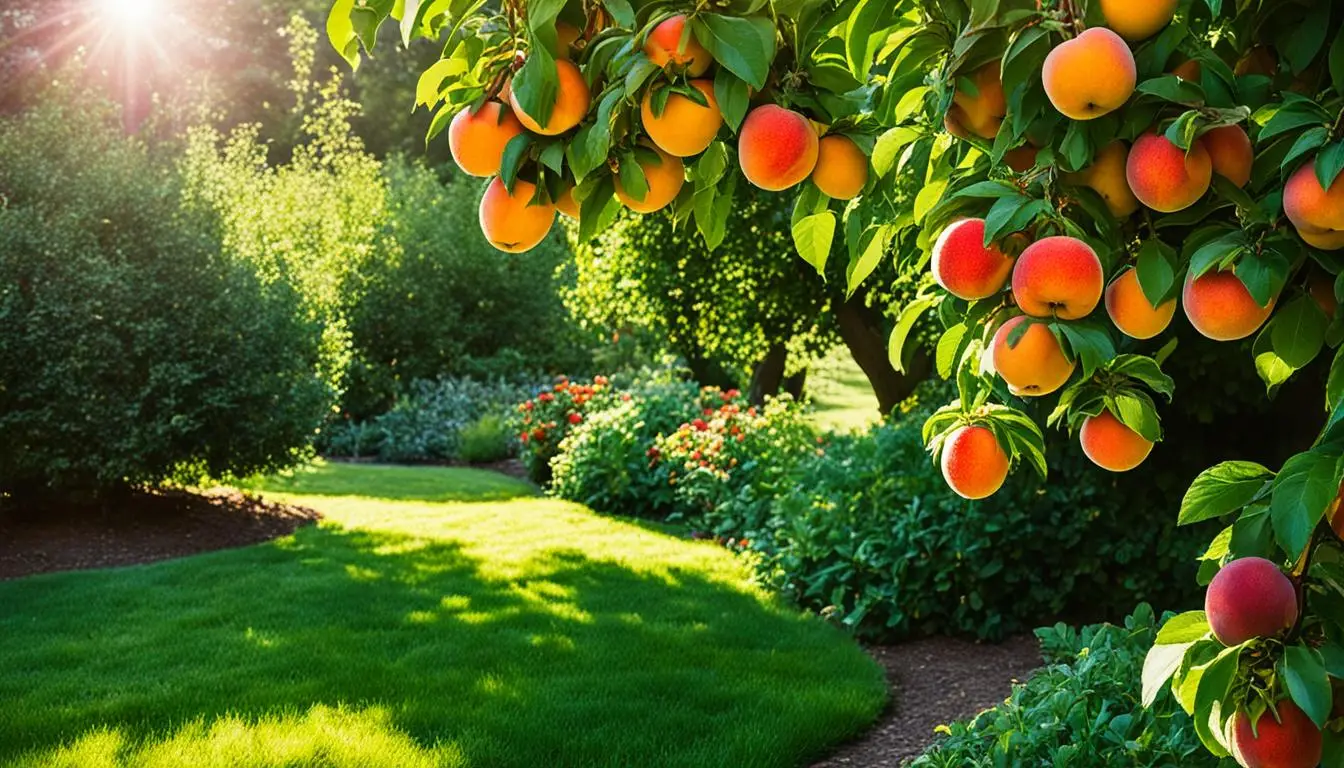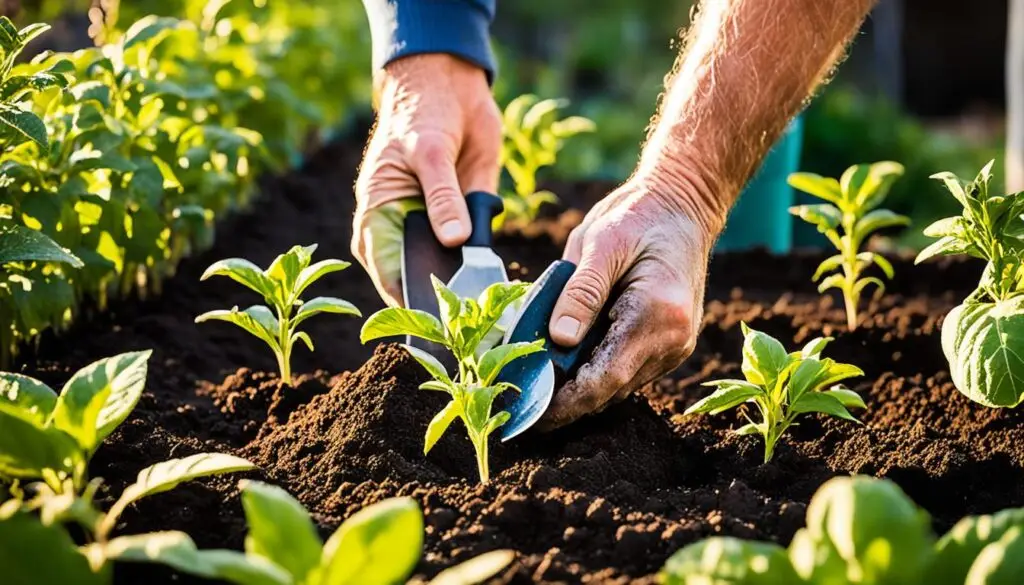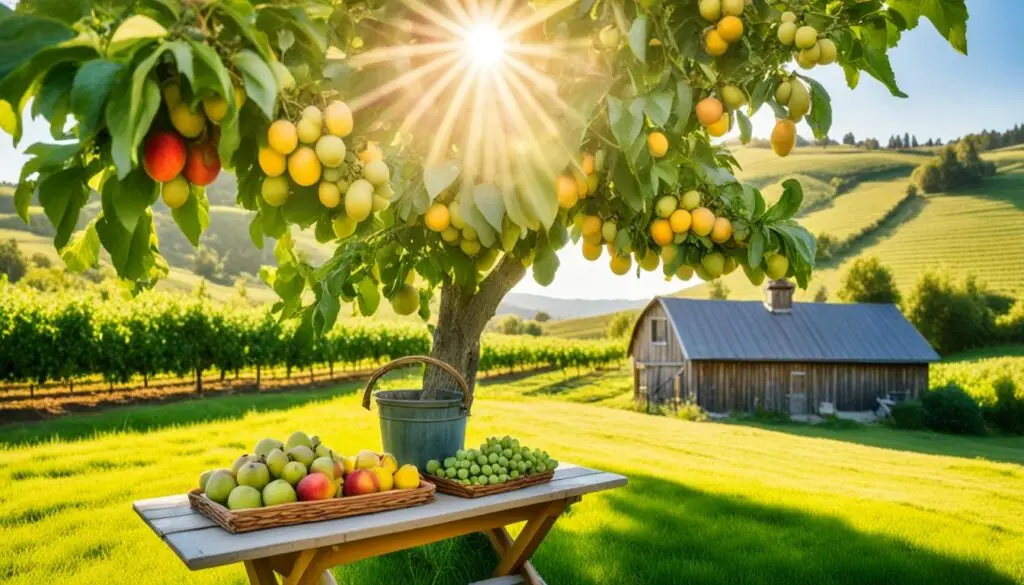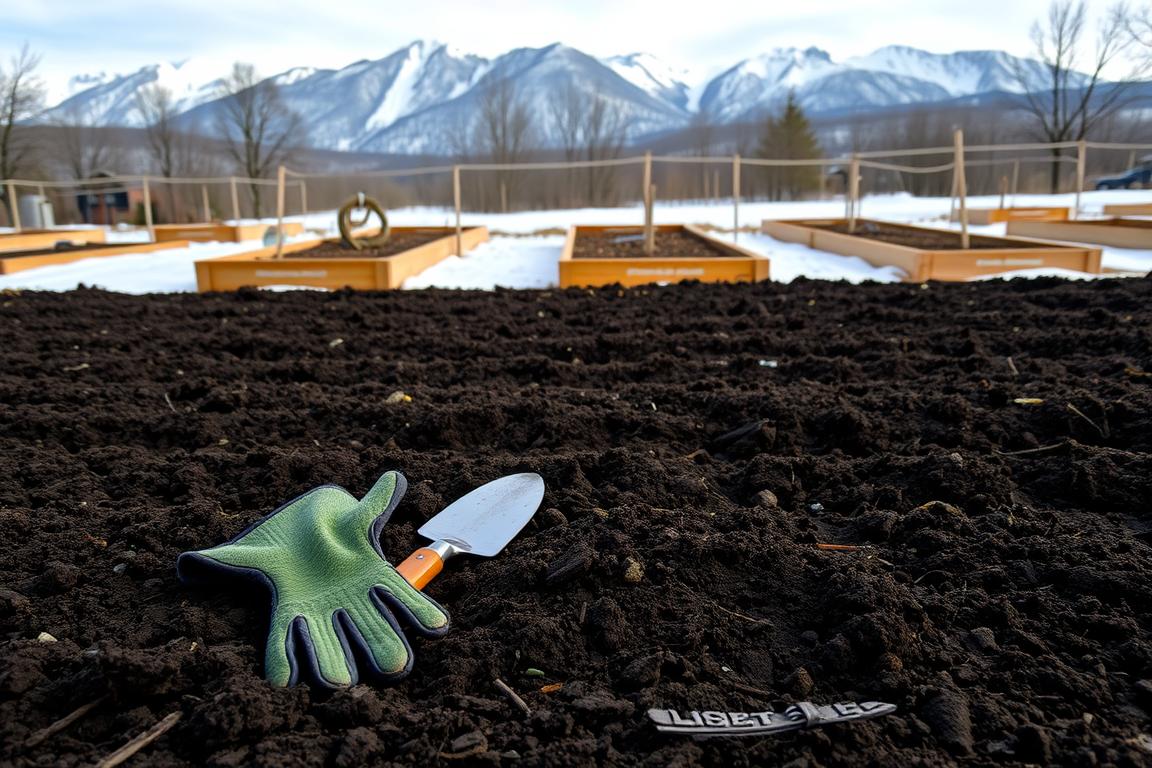Growing your own fruit and vegetables is a fun and rewarding way to utilize your garden. Nothing compares to the taste of homegrown fruit plucked straight from the tree, or the crunch of freshly harvested vegetables. However, getting started with fruit cultivation can feel daunting. This comprehensive guide contains everything you need to know to begin growing your own fruits, including tips on selecting the right plants, preparing the soil, and caring for your fruit-bearing plants.
Key Takeaways
- Homegrown fruits offer unparalleled taste and nutrition compared to store-bought produce.
- Fruit gardening is a fun and rewarding activity that promotes sustainable living.
- Choosing the right plants for your climate and available space is crucial for success.
- Proper soil preparation, planting techniques, and ongoing care are essential for a thriving fruit garden.
- Fruit trees, berry bushes, and even container-grown options can all be incorporated into your home garden.
Why Grow Your Own Fruits?
Growing your own fruits offers a variety of benefits for home gardeners. Firstly, the taste and nutrition of homegrown fruits is unparalleled. Fruits picked straight from the plant are bursting with flavor and packed with vital nutrients, often far exceeding the quality of store-bought produce.
Taste and Nutrition
When you grow your own fruits, you have the opportunity to savor the true, unadulterated flavors of nature’s bounty. These freshly harvested fruits are not only delicious but also boast superior nutritional value compared to their commercially-grown counterparts. By cultivating your own organic organic produce, you can ensure your family enjoys the most nutritious and flavorful fruits possible.
Fun and Rewarding Activity
Fruit gardening is a fun and rewarding activity that can bring a sense of accomplishment and connection with nature. The act of planting, nurturing, and harvesting your own fruits can be a deeply satisfying experience, fostering a greater appreciation for the natural world and the origins of the food we consume. Whether you have a sprawling backyard or a cozy urban garden, growing your own fruits can be a fulfilling hobby that the whole family can enjoy.
Sustainable Living
By cultivating your own fruits, you can contribute to a more sustainable living approach. Permaculture and organic farming principles can be applied to your home fruit garden, reducing your carbon footprint and promoting urban farming practices. This not only provides you with fresh, organic produce but also helps to support sustainable horticulture and urban gardening initiatives in your local community.
Getting Started with Fruit Gardening
To embark on your fruit gardening journey, the first crucial step is to select the right plants that thrive in your local climate, available space, and align with your personal preferences. When choosing fruit trees, berry bushes, and other edible options, consider factors such as plant hardiness, sun exposure requirements, and the eventual size of the mature plants.
Choosing the Right Plants
Carefully evaluating your growing conditions and desired outcomes is essential when selecting the right plants for your home fruit garden. Research the specific needs and characteristics of different fruit trees, berry bushes, and other edible plants to ensure a successful harvest. Factor in elements like climate, sunlight, and available space to make informed decisions that will set your fruit cultivation endeavor up for long-term thriving.
Preparing the Soil
Once you have chosen the fruit trees, berry bushes, and other edible plants that will flourish in your home gardening space, the next step is to prepare the soil for planting. Amend the soil with organic matter, such as compost or well-rotted manure, to enhance nutrient levels and improve drainage. Testing the soil pH and adjusting it to the optimal range for your selected edible plants will also contribute to their healthy growth and productive yields.
Planting and Caring for Your Fruit Plants
With the right plants chosen and the soil properly prepared, it’s time to embark on the rewarding process of planting and caring for your fruit-bearing plants. Carefully follow the recommended planting depth and spacing guidelines to ensure your fruit trees, berry bushes, and other edible options have the optimal conditions to thrive. Consistent watering, mulching, and ongoing maintenance are crucial for the long-term success of your home fruit garden, urban gardening, and sustainable living endeavors.
“Growing Your Own Fruits: A Guide for Home Gardeners”
Growing your own fruit can be a rewarding and enjoyable experience for home gardeners. From the juicy sweetness of freshly picked apples to the tangy delight of homegrown berries, cultivating your own fruit offers a wealth of benefits. In this section, we’ll explore the different types of fruit plants you can incorporate into your home garden, including fruit trees, berry bushes, and options for containers and small spaces.
Fruit Trees
Fruit trees, such as apples, pears, and cherries, can be a wonderful addition to your home garden. When selecting fruit trees, consider the mature size of the plant and opt for dwarf or semi-dwarf varieties if you have limited space. The dormant season, between autumn and spring, is the ideal time to plant fruit trees for the best results. If you live in an area without a large number of nearby fruit trees, choose self-fertile varieties to ensure reliable pollination and consistent fruit production.
Berry Bushes
Berry bushes, including blueberries, raspberries, and blackberries, are another excellent choice for the home fruit garden. These plants can often thrive in smaller spaces and containers, making them a versatile option for urban gardeners or those with limited outdoor area. When planning your berry bushes, research the specific growing requirements and choose varieties well-suited to your climate and available sunlight.
Containers and Small Spaces
Even with limited space, you can still enjoy the pleasures of homegrown fruit. Many fruit trees and berry bushes can be successfully grown in containers, allowing you to bring the bounty of a backyard orchard to your patio, balcony, or small garden. When selecting container-friendly fruit plants, look for dwarf or compact varieties, and ensure the containers have adequate drainage and soil quality to support their growth.
| Fruit Type | Recommended Varieties for Containers | Planting and Care Tips |
|---|---|---|
| Apples | Dwarf or semi-dwarf apple trees, such as ‘Patio’ or ‘Spire’ | Choose a container at least 18 inches deep, provide full sun, and water regularly |
| Blueberries | Compact, bush-type blueberry varieties like ‘Northsky’ or ‘Tophat’ | Plant in acidic, well-draining soil and ensure the container has adequate drainage |
| Strawberries | Everbearing or day-neutral strawberry cultivars like ‘Seascape’ or ‘Albion’ | Grow in a shallow, wide container and ensure the plants receive at least 6 hours of direct sunlight per day |
By incorporating fruit trees, berry bushes, and container-grown options, you can create a thriving home fruit garden that provides a bountiful harvest and enhances the beauty of your outdoor living space. With the right plant selection and proper care, you can enjoy the fresh, flavorful fruits of your labor for years to come.
Maintenance and Care
Proper maintenance and care are essential for the long-term success of your home fruit garden. Regular pruning and training of your fruit trees and berry bushes shape their growth, promote fruitfulness, and maintain their overall health. Follow the recommended pruning techniques and schedules to ensure your plants thrive and continue producing an abundant harvest year after year.
Pruning and Training
Pruning is a crucial task that helps your fruit trees and berry bushes reach their full potential. Proper pruning techniques, such as thinning out crowded branches, removing dead or damaged growth, and shaping the plant’s structure, encourage better air circulation, increase sunlight penetration, and stimulate the production of healthy, flavorful fruit. Familiarize yourself with the appropriate pruning methods for each type of fruit plant to optimize their growth and productivity.
Pest Control
Protecting your fruit plants from pests and diseases is essential for maintaining a healthy, thriving home garden. Regularly inspect your plants for signs of insect infestations or fungal diseases, and take proactive measures to address any issues. Utilize eco-friendly pest control methods, such as introducing beneficial insects, applying organic pesticides, or implementing physical barriers, to keep your fruit plants free from harm without compromising the safety of your produce.
Harvesting and Storage
Knowing when and how to harvest your fruit is key to enjoying the full flavor and nutrition of your home-grown bounty. Learn the ideal harvesting time and techniques for each type of fruit, ensuring you pick them at the peak of ripeness. After harvesting, proper storage methods, such as refrigeration, canning, or freezing, can help extend the shelf life of your fruits and allow you to savor their flavors year-round.
| Maintenance Task | Frequency | Tips |
|---|---|---|
| Pruning | Annually, during dormant season | Follow specific pruning techniques for each fruit type |
| Pest Monitoring | Monthly, or as needed | Use organic, environmentally-friendly pest control methods |
| Harvesting | Varies by fruit type | Harvest at the peak of ripeness for maximum flavor and nutrition |
| Fruit Storage | Varies by fruit type | Preserve fruits through canning, freezing, or other methods |
Conclusion
Growing your own fruits at home is a rewarding and sustainable way to enjoy the taste and nutrition of fresh, homegrown produce. By following the guidance in this comprehensive guide, you can successfully cultivate a thriving fruit garden, whether you have a large backyard or a small patio. From choosing the right plants to maintaining and caring for your fruit crops, this article has provided you with the essential information to get started on your home fruit gardening journey.
Embrace the many benefits of growing your own fruits, and savor the delicious rewards of your labor. With the right planning and dedication, you can transform your outdoor space into a bountiful oasis, filled with the vibrant colors and flavors of your very own homegrown fruits. Take the first step towards a more sustainable, self-reliant, and flavorful lifestyle by embarking on your home fruit gardening adventure today.
The journey of growing your own fruits may have its challenges, but the satisfaction and pride of harvesting your own organic, nutrient-rich produce will make it all worthwhile. Immerse yourself in the beauty and bounty of your homegrown fruit garden, and savor the delectable rewards of your hard work and green-fingered efforts.
FAQ
What are the benefits of growing your own fruits?
Growing your own fruits offers several benefits, including superior taste and nutrition, a fun and rewarding activity, and a more sustainable living approach.
How do I choose the right fruit plants for my garden?
When selecting fruit plants, consider factors like plant hardiness, sun exposure, and eventual size to choose the right options for your climate and available space.
How do I prepare the soil for fruit gardening?
Proper soil preparation is crucial for the success of your fruit plants. Amend the soil with organic matter and ensure it has the right pH and nutrient balance.
What are the key maintenance tasks for a home fruit garden?
Regular pruning and training of your fruit trees and berry bushes, along with effective pest control and proper harvesting techniques, are essential for maintaining a thriving home fruit garden.
Can I grow fruits in small spaces or containers?
Yes, you can grow a variety of fruits, including dwarf fruit trees and berry bushes, in containers or small spaces like patios and balconies.
How do I ensure my fruit plants are pollinated?
To ensure reliable pollination and fruit production, choose self-fertile fruit varieties or consider introducing pollinators like bees to your garden.
How do I store and preserve my homegrown fruits?
There are various methods for storing and preserving your harvested fruits, such as canning, freezing, and dehydrating, to enjoy your bounty year-round.








